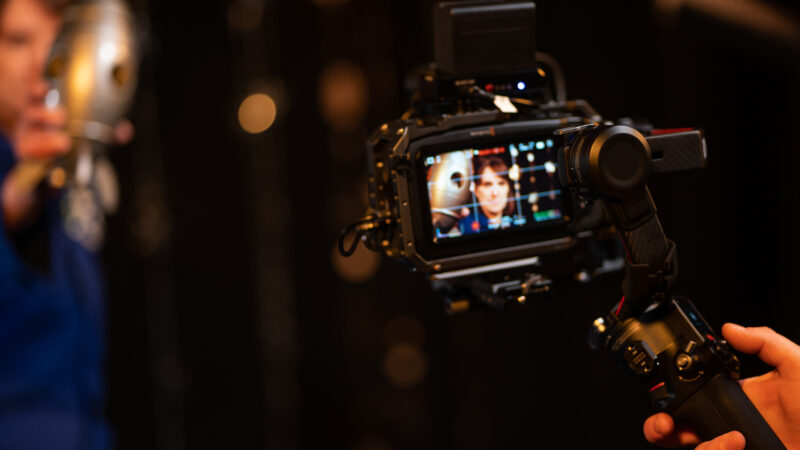Michael Ogden, Associate Consultant to The Space and Host of CrowdSceneShow.com shares insights on turning great ideas into compelling propositions.
The sensation of having a good idea is intoxicating. That spark of a new concept – gifted from a passing comment, or a memory recalled, or an arresting convergence of events – can make your brain buzz! The world takes on a fresh sheen – and, suddenly, it’s like everything you see and hear makes your idea even richer, more convincing, and more compelling. You know that THIS is just what the world needs; this is the direction that you MUST steer your energy towards. Hold my calls! There is no time to waste…. I am a GENIUS!
I’ve had that feeling As a Creative Director for PlayStation, and in my recent role at The Space overseeing creative development, I know it first-hand. But I also know that with any concept, there comes a moment of choice: leave that idea in your mind, and play with it from time to time, safe in the knowledge that it exists in a state of flawless perfection. Because as long as you never make it, or tell anyone about it, it won’t ever fall short of your heady expectations… Or, there is an alternative. You can choose to make it.
The Space wants to help you do just that. But for The Space – or any funding body – to be in a position to provide support, you’re going to have to share your concept in a manner and a language that makes sense. I know for many artists that can be difficult: and the fear is that you will stumble through an awkward attempt to give voice to your idea and it’ll be met with a deadening silence, and deep inside, you will worry that far from being an amazing idea, maybe it’s actually the dumbest idea ever shared by a human being! Only blind faith or experience will fortify you from immediately tossing it in the bin. But stay strong – there is a way!
In this blog, I’m going to share with you some simple steps (and exercises at the end) to keep that vulnerable, precious idea of yours alive – atleast until you’re confident it has legs. It’s what I look for in a project, (and when I’m working up my own concepts, this is my approach too). So, here you go: 3 Things Every Successful Proposal Gets Right:
1. Identify Your Core Concept (AKA Project Summary)
Your core concept, or ‘project summary’, is the first thing that gets read. This is your curtain raiser, and the moment that brings people into your vision and sets the scene for your project. As someone who often reviews pitches, I can tell you we need to understand what you are going to do, where you are doing it and why it’s important to you. Get us on board with your idea here, and up front, and you’ll find so much of the work is already done.
To do this, work towards being able to share your concept coherently with another person. Try and capture your experience in just a couple of sentences. It’s important that your core concept is easy to communicate, memorable & easy to pass on. Choose your words carefully. Rehearse and revise. It’s a challenge to get this part right – but it’s worth it.
By the way, it may be tempting to toss in terms like ‘innovative’, ‘paradigm’ and ‘technology’. Don’t. Keep it simple. Avoid jargon. Say what it is. The aim is to share your idea in a way that a stranger (and ultimately a stranger who has money to support your project) says this, “I get it.” They may still say no, but not because they were confused by it.
Don’t make the mistake that many do and describe your concept using marketing language and a snappy tagline. That’s not a core concept. What’s the difference?
A tagline is a piece of marketing copy designed to go on posters and sell. Here’s an example: “In space, no one can hear you scream” (Alien)
In contrast, your project summary should contain all the elements necessary for telling your story. You should still be able to describe your core idea – even a future masterpiece – in a language that others can understand. Recognize this Best Picture Oscar winner?
“When a powerful gangster is gunned down, his reluctant son must seek revenge and take over the family business.”
And if you play games, you might describe “The Sims” like this:
“Create virtual people and run their lives”
A recent example from The Space’s commissions, is the Ai Weiwei project. Here’s the core concept shared in the original proposal:
An interactive online art exhibition for desktop, tablets and mobile phones designed to simulate the experience of visiting the Royal Academy’s landmark Ai Weiwei retrospective.
So right up front, we know what it is: ‘exhibition’, where it is taking place: ‘online’, and why it is important: ‘it’s inspired by a landmark event’.
2. Clarify Your Key Features
Key features are what your audience will be ‘doing’. In defining your key features, consider the experience from the audience’s perspective. How do they participate? What do they see? This may sound obvious, but I’ve seen many teams either not address this question, ask it too late, or struggle to agree and get it right.
Your key features should tell us precisely what your audience will be doing in the course of the experience. An example: they might be 1) following a story, 2) playing mini-games, and 3) exploring a 3D world. Those are 3 key features.
To keep your experience focused and well-defined stick to identifying 3 strong key features – and no more than 5.
Why? More than 5 and you may find your concept is half-baked and not going to deliver a compelling, core experience. Simplify, fortify, and strengthen what you have. Stick to communicating what is unique, distinctive, and appealing. If you’re talking to a friend, what key things do you mention to explain the experience?
Note that your Key Features need to support and deliver on the promise set by your Project Summary. If they don’t then you’ll need to revise until your concept and features are “speaking” to each other.
If we look at the Ai Weiwei example, those key features were articulated this way:
• Navigate from room to room using mouse or cursor to explore the exhibition and select individual works
• Study the art from a variety of camera angles
• Watch videos of exhibition curators, analysts and Ai WeiWei himself discussing the work in detail
So with these Key Features outlined, we can envisage the audience’s experience in the artwork, understanding what they will see and do in the project space.
3. Know Your Audience
You may find your concept irresistible (good!) but no project is universally appealing. You may hope for a broad audience, but as you’re shaping your concept, specifically consider which groups might constitute your core audience. Avoid saying ‘it’s for everybody.’
Audience profiling may sound like a marketing exercise, but it’s not. By identifying who your concept is really for, you will be more alert to opportunities around you that are right for this particular project.
What you are looking to get on the table are all of your creative opportunities that will enable you and your team to make the concept exceptional. And that means having an intimate understanding of who will want – and who needs – to experience your artwork.
Ask yourself: Who will find the project of most interest and what might motivate them to participate? Understanding their needs and interests will also increase your ability to make lateral connections that will enrich your concept and make it more distinctive. If your understanding of your audience is surface, and your language around your hoped-for audience is peppered with clichés, then your concept will likely feel the same.
By being able to express who your audience is to others, you will also increase the chances of organisations like The Space connecting you to appropriate partners (Spotify, Tumblr, etc), and/or to team members that have experience working with the audience you have in mind.
I always think it’s important to personalise this as well – would YOU want to experience this artwork? Best not to always think strategically (‘what does the market need?’) but to put your time and effort and brain power into something that really tickles your own imagination. If you do it honestly and authentically, you will find there are others out there like you. Recognizing who and where those people are, will improve your experience and maximise its impact.
Here’s an example of Audience profile from Ai Weiwei:
• Fans of Ai Weiwei who were unable to see the exhibition in London – extending the life and reach of the exhibition
• Attendees who want to repeat or deepen their Royal Academy experience
• Metro-culturals inspired by the artists’s themes around censorship; Experience seekers intrigued by the use of VR
Again, this is a simple and convincing outline of distinct audiences. Development teams will then be able to assess how to activate their resources to increase opportunities for outreach.
Conclusion
Remember that buzz you felt when you first had that idea? If you’re like me, you’ll want your audience to feel that same spark, and “hear” what you’re saying with your work. Let them feel the sensation you feel. Let them feel the penny drop. To do that requires being an excellent communicator – not only with your intended audience, but first, and at this early stage, with your collaborators: your creative team, your distributors, and potential financiers! If they understand what it is you’re making, they will then be best placed to help you deliver it in the best way possible.
Ulimately, it’s all about language. Your goal in getting your proposal right is about finding like-minded collaborators who share your vision as you describe it. It’s not to sell it to just anyone who wants what you have, but to find the people who believe what you believe, who see what you see, who will rally for you, who will laugh at your jokes, and fight for your cause…
Final checklist:
• Can you communicate your concept in less than a minute? Or in a few sentences?
• Are people able to pitch it back to you coherently?
• Is your core concept being delivered by the key features you’ve identified?
• Will your key features make for a compelling, impactful experience?
• Would a reader of your proposal have a clear and specific idea who your core audience is?
• Will your intended audience find your concept convincing?
• Have you removed all jargon, and shared your vision simply, in a clear language?
If so, you’re doing well. Good luck!
If you need help in working through the ideas above, I’ve developed a series of prompts and exercises to stir your brain.
Making an Idea Great Exercises.pdf
As a Creative Director, Michael Ogden has worked extensively with Sony PlayStation and Pixar and acted as the Interim Director of Creative Development at The Space. Michael still works with The Space as an Associate consulting on selected projects. He is also the author of the ideas book, 2DO Before I Die and the host of the podcast Crowd Scene Show (CrowdSceneShow.com) where he interviews entrepreneurs and artists about their creative process.




